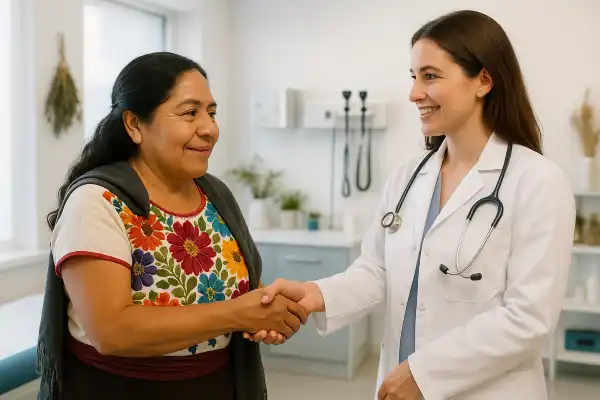Curanderismo vs modern medicine represents one of the most thoughtful conversations emerging in contemporary healthcare, particularly among communities seeking to honor ancestral wisdom while embracing scientific advancement. This inquiry reflects a deeper yearning for healing approaches that address not only physical symptoms but also spiritual and emotional well-being.
María del Pilar Fernández, drawing from her lineage of curanderas and academic training in cultural anthropology, believes this question arises from a growing recognition that true healing often requires more than what either system can offer alone. She approaches this comparison with reverence for both traditions, understanding that each holds unique gifts for those seeking restoration and balance.
Curanderismo vs modern medicine
Curanderismo and modern medicine represent two distinct yet potentially complementary approaches to healing, where curanderismo offers holistic treatment addressing physical, emotional, mental, and spiritual aspects of illness, while modern medicine excels in diagnostics, emergency care, and evidence-based treatments for specific conditions.

Philosophical foundations and worldview
Curanderismo operates from a holistic worldview that sees illness as an imbalance between the individual, their environment, and spiritual forces, integrating Indigenous healing traditions, Spanish folk medicine, and Catholic elements. This ancient practice recognizes that health encompasses far more than the absence of disease—it requires harmony between body, mind, spirit, and community.
Modern medicine, conversely, approaches health through the biomedical model, focusing on diagnosing and treating specific pathological processes using scientifically validated methods. While Western medicine excels at addressing acute conditions and providing evidence-based treatments, research indicates it may fall short in addressing certain spiritual and emotional aspects of healing that curanderismo traditionally encompasses.
Treatment approaches and methodologies
Curanderos employ diverse healing techniques including herbal remedies, massage (sobada), spiritual cleansings (limpias), prayers, and ceremonial rituals, often incorporating elements from nature and sacred symbols. These treatments are personalized not only to physical symptoms but also to the patient’s spiritual condition, family dynamics, and cultural context.
Modern medicine utilizes pharmaceuticals, surgical procedures, diagnostic imaging, laboratory tests, and standardized treatment protocols based on clinical research. The strength of conventional medicine lies in its ability to address acute conditions, provide emergency interventions, and offer treatments backed by rigorous scientific testing.
Effectiveness and therapeutic outcomes
Research examining curanderismo’s effectiveness found that it demonstrates similar success rates to Western mental health practices, with studies showing approximately 75% effectiveness compared to conventional mental health treatment rates of 70%. However, these systems often address different aspects of health and healing.
Curanderismo proves particularly effective for stress-related conditions, anxiety, depression, and spiritual ailments, offering patients a sense of empowerment and cultural connection that enhances the healing process. Modern medicine demonstrates clear superiority in treating infections, performing surgery, managing chronic diseases like diabetes and hypertension, and providing emergency care.
Cultural relevance and accessibility
Among Hispanic populations in the United States, studies reveal that 21.4% of Mexican-American women had sought care from curanderos within the past five years, with utilization significantly higher among Spanish-speakers and those who had recently immigrated. Families often choose curanderismo because it is more affordable than conventional medicine, addresses language and cultural barriers, and provides spiritual healing that traditional physicians cannot offer.
The economic factor proves particularly significant, as many uninsured individuals cannot afford modern medical treatments but can access curanderismo services, which often require minimal payment or simple offerings.
Integration and complementary use
Rather than viewing these systems as opposing forces, emerging research supports their integration, with Hispanic patients often using curanderismo alongside conventional medicine rather than as exclusive alternatives. Elderly Hispanic populations typically rely on modern medicine for serious health issues while turning to curanderismo when conventional treatments prove unsatisfactory or for less serious conditions.
Mexico has begun experimenting with integrative healing programs, where the Universidad Intercultural del Estado de México offers bachelor’s programs training students in both curanderismo practices and conventional medicine, with graduates now working officially in hospitals and communities.
Areas of strength and limitation
Curanderismo excels in providing culturally resonant care, addressing psychosocial and spiritual needs, offering affordable treatment options, and treating conditions that modern medicine may struggle with, such as susto (spiritual fright), anxiety disorders rooted in cultural trauma, and family relationship conflicts.
Modern medicine provides superior treatment for infectious diseases, surgical conditions, cancer, cardiovascular emergencies, and conditions requiring precise pharmaceutical interventions. Research confirms that curanderos acknowledge these limitations and regularly refer patients to medical doctors when necessary.
The path toward integration
Leading curanderismo educators advocate for integration rather than competition, recognizing that “we can always benefit from the integration of different ways of thinking, ways of living, ways of believing,” particularly when addressing the complete spectrum of human health needs.
This integration offers the potential for more holistic patient care, where modern medicine’s diagnostic capabilities and pharmaceutical treatments combine with curanderismo’s cultural competence, spiritual healing, and community-centered approach. Such collaboration could prove especially valuable in addressing healthcare disparities among Hispanic populations and providing culturally competent care that honors both scientific advancement and ancestral wisdom.
Disclaimer
Please note that Maria is not a physician, psychologist, or nurse. These culture-specific spiritual healing services are not meant to replace medical or psychological diagnosis and treatment. It is recommended that you see a licensed physician or licensed health care professional for any physical or psychological ailment you may have.
Recently, María worked with Valentina, a young mother from Guadalajara who had been struggling with persistent anxiety and insomnia following the birth of her daughter. After months of conventional treatments that provided only partial relief, Valentina’s grandmother suggested she visit María. Through a combination of herbal teas prepared with manzanilla and toronjil, gentle sobada massage to release tension held in her shoulders and neck, and a limpia ceremony to cleanse the spiritual heaviness she carried from a difficult birth experience, Valentina began to find peace. María also encouraged her to continue working with her primary care physician, recognizing that true healing often requires honoring both the wisdom of our ancestors and the gifts of modern medicine. Within several weeks, Valentina reported sleeping through the night and feeling reconnected to her strength as both a woman and mother, demonstrating how curanderismo can complement conventional care in addressing the whole person.
